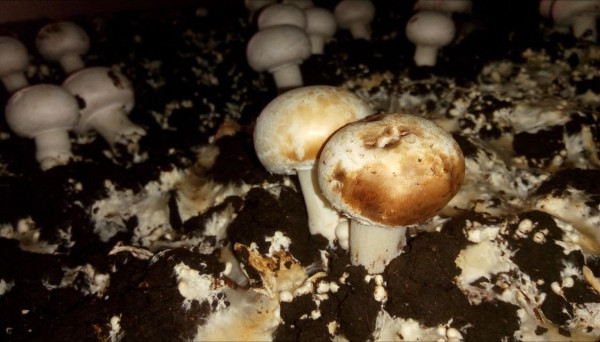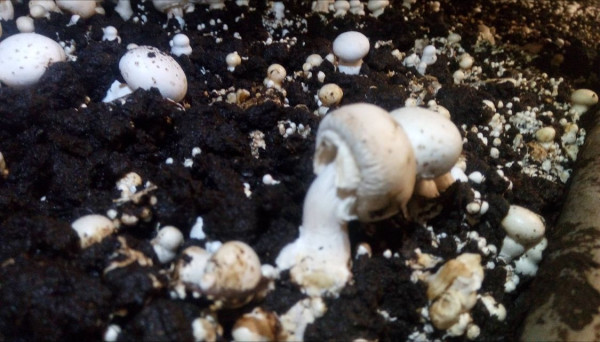박테리아로 인한 질병
본문
In this post, I write about diseases caused by bacteria in button mushrooms. The origin of many bacteria is the soil. Actually, most of the bacteria, both the beneficial ones and the ones that is pathogenic, are present in the casing soil. Most of the time, pathogenic bacteria cause a decrease in quality, but some types of them also decrease the quantity, and sometimes they can be very dangerous. The most famous type of bacteria that spreads quickly is the Blotch, Bacterial blotch or Brown blotch type of bacteria. This bacteria needs moisture to multiply and spread. A mistake in controlling the humidity and temperature in the production rooms can cause a disaster, and tomorrow you will face discolored, yellow and brown mushrooms on the bed. All this is because of a small mistake made by grower or disruption in the controlling system. If we understand that every bacterium doubles every 20 minutes, we will never take any risk about them. Experience has proven to me that high moisture is not only causes the spread of bacterial blotch, but the drop in the temperature of the compost after irrigation or during the harvesting period with constant humidity also plays a role in the spread of bacterial blotch. One day, a professor asked me, if you want to describe mushroom cultivation with one word, what would that word be? Evaporation!!! This was my answer. If evaporation is done correctly in production rooms, the risk of bacterial blotch outbreak will be minimized. Evaporation is a science and requires specialized investigation. However, there are two methods of evaporation in the mushroom growing stage. One is environmental evaporation and the other is the difference between room temperature and compost temperature, which is called compost activity. In active composts, the risk of bacterial blotch is reduced.
Among other types of diseases caused by bacteria, Mummy can reduce production and even reduce it to zero.
Pit is another type of bacterial disease, which in my opinion is more dangerous than bacterial spots. Needle spots and spots that multiply quickly.
Soft rot is also a kind of disease that is not very common and no damage has been reported so far, but the smell caused by it is harmful to humans.
Sometimes discoloration after harvest is caused by bacteria. Called per harvest browning.
번역
이 글에서는 단추 버섯의 박테리아로 인한 질병에 대해 씁니다. 많은 박테리아의 기원은 토양입니다. 실제로, 유익한 박테리아와 병원성 박테리아 모두의 대부분은 케이싱 토양에 존재합니다. 대부분의 경우 병원성 박테리아는 품질 저하를 일으키지만 일부 유형은 양을 감소시키기도 하며 때로는 매우 위험할 수 있습니다. 빠르게 퍼지는 가장 유명한 유형의 박테리아는 얼룩, 박테리아 얼룩 또는 갈색 얼룩 유형의 박테리아입니다. 이 박테리아는 증식하고 퍼지기 위해 수분이 필요합니다. 재배사의 습도와 온도 조절에 실수하면 재앙이 발생할 수 있으며, 내일은 침대에서 변색되고 노란색과 갈색 버섯을 마주하게 될 것입니다. 이 모든 것은 재배자의 작은 실수 또는 제어 시스템의 혼란 때문입니다. 모든 박테리아가 20분마다 두 배로 늘어난다는 것을 이해한다면, 우리는 박테리아에 대해 어떤 위험도 감수하지 않을 것입니다. 경험에 따르면 높은 수분은 세균성 반점의 확산을 유발할 뿐만 아니라 관개 후 또는 일정한 습도로 수확 기간 동안 퇴비의 온도 강하도 세균성 반점의 확산에 중요한 역할을 합니다. 어느 날 한 교수가 버섯 재배를 한 단어로 표현한다면 그 단어는 무엇이냐고 물었습니다. 증발!!! 이것이 내 대답이었다. 재배사에서 증발이 올바르게 수행되면 박테리아 얼룩 발생의 위험이 최소화됩니다. 증발은 과학이며 전문적인 조사가 필요합니다. 그러나 버섯 성장 단계에서 증발하는 방법에는 두 가지가 있습니다. 하나는 환경 증발이고 다른 하나는 실온과 퇴비 온도의 차이로, 이를 퇴비 활동이라고 합니다. 활성 퇴비에서는 박테리아 얼룩의 위험이 줄어 듭니다.
박테리아에 의해 유발되는 다른 유형의 질병 중에서도 미라는 생산량을 감소시킬 수 있으며 심지어 0으로 줄일 수도 있습니다.
구덩이는 세균성 질병의 또 다른 유형으로, 제 생각에는 세균성 반점보다 더 위험합니다. 바늘 반점과 빠르게 증식하는 반점.
무름병도 흔하지 않은 질병의 일종으로 지금까지 피해는 보고되지 않았지만 그로 인한 냄새는 인체에 해롭습니다.
때때로 수확 후 변색은 박테리아에 의해 발생합니다. 수확 브라우닝에 따라 호출됩니다.
Among other types of diseases caused by bacteria, Mummy can reduce production and even reduce it to zero.
Pit is another type of bacterial disease, which in my opinion is more dangerous than bacterial spots. Needle spots and spots that multiply quickly.
Soft rot is also a kind of disease that is not very common and no damage has been reported so far, but the smell caused by it is harmful to humans.
Sometimes discoloration after harvest is caused by bacteria. Called per harvest browning.
번역
이 글에서는 단추 버섯의 박테리아로 인한 질병에 대해 씁니다. 많은 박테리아의 기원은 토양입니다. 실제로, 유익한 박테리아와 병원성 박테리아 모두의 대부분은 케이싱 토양에 존재합니다. 대부분의 경우 병원성 박테리아는 품질 저하를 일으키지만 일부 유형은 양을 감소시키기도 하며 때로는 매우 위험할 수 있습니다. 빠르게 퍼지는 가장 유명한 유형의 박테리아는 얼룩, 박테리아 얼룩 또는 갈색 얼룩 유형의 박테리아입니다. 이 박테리아는 증식하고 퍼지기 위해 수분이 필요합니다. 재배사의 습도와 온도 조절에 실수하면 재앙이 발생할 수 있으며, 내일은 침대에서 변색되고 노란색과 갈색 버섯을 마주하게 될 것입니다. 이 모든 것은 재배자의 작은 실수 또는 제어 시스템의 혼란 때문입니다. 모든 박테리아가 20분마다 두 배로 늘어난다는 것을 이해한다면, 우리는 박테리아에 대해 어떤 위험도 감수하지 않을 것입니다. 경험에 따르면 높은 수분은 세균성 반점의 확산을 유발할 뿐만 아니라 관개 후 또는 일정한 습도로 수확 기간 동안 퇴비의 온도 강하도 세균성 반점의 확산에 중요한 역할을 합니다. 어느 날 한 교수가 버섯 재배를 한 단어로 표현한다면 그 단어는 무엇이냐고 물었습니다. 증발!!! 이것이 내 대답이었다. 재배사에서 증발이 올바르게 수행되면 박테리아 얼룩 발생의 위험이 최소화됩니다. 증발은 과학이며 전문적인 조사가 필요합니다. 그러나 버섯 성장 단계에서 증발하는 방법에는 두 가지가 있습니다. 하나는 환경 증발이고 다른 하나는 실온과 퇴비 온도의 차이로, 이를 퇴비 활동이라고 합니다. 활성 퇴비에서는 박테리아 얼룩의 위험이 줄어 듭니다.
박테리아에 의해 유발되는 다른 유형의 질병 중에서도 미라는 생산량을 감소시킬 수 있으며 심지어 0으로 줄일 수도 있습니다.
구덩이는 세균성 질병의 또 다른 유형으로, 제 생각에는 세균성 반점보다 더 위험합니다. 바늘 반점과 빠르게 증식하는 반점.
무름병도 흔하지 않은 질병의 일종으로 지금까지 피해는 보고되지 않았지만 그로 인한 냄새는 인체에 해롭습니다.
때때로 수확 후 변색은 박테리아에 의해 발생합니다. 수확 브라우닝에 따라 호출됩니다.

